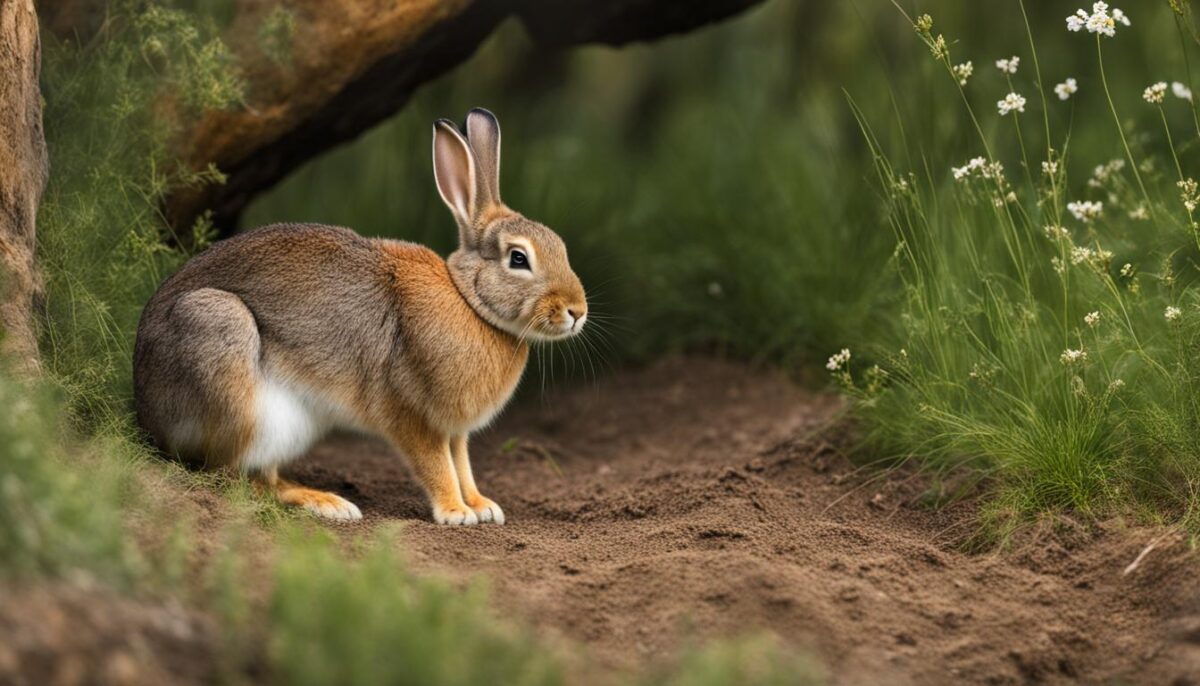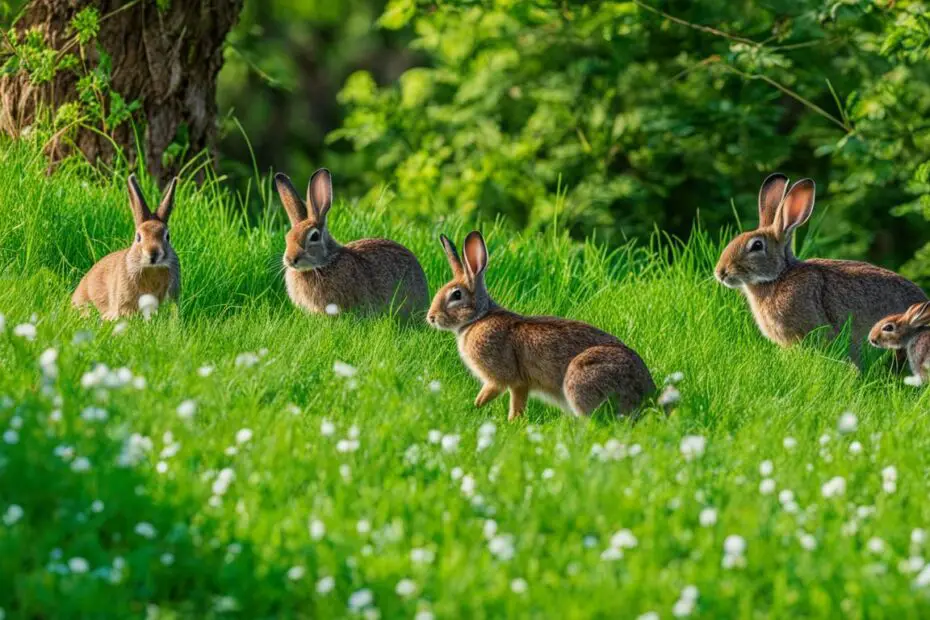Rabbits are fascinating creatures that can be found in various environments around the world. If you’ve ever wondered where these furry friends call home, you’re in for a treat! In this article, we’ll explore the natural habitat of wild rabbits and uncover the intriguing places they inhabit.
Belonging to the Leporidae family, rabbits are small mammals that come in different species but share common characteristics. They range in size from as small as 9.3 inches to as big as 4 feet 3 inches. With a herbivorous diet, rabbits enjoy munching on grasses, clover, fruits, and more. Their breeding patterns consist of multiple times a year, ensuring their populations thrive.
When it comes to their habitats, wild rabbits can be found in various landscapes, including woods, meadows, grasslands, and wetlands. They are particularly adept at creating their own homes by burrowing into the ground, forming intricate tunnel systems known as warrens. These warrens serve as both shelter and a safe place to raise their young.
Living in large groups called colonies, rabbits are highly social animals. However, they face constant threats from predators such as owls, foxes, and wild dogs. Despite the challenges they encounter, rabbits have developed remarkable adaptations that allow them to survive in the wild.
Key Takeaways:
- Wild rabbits can be found in woods, meadows, grasslands, and wetlands.
- They create their homes by burrowing into the ground, forming tunnel systems called warrens.
- Rabbits are social animals and live in large groups called colonies.
- Predators such as owls, foxes, and wild dogs pose a constant threat to wild rabbits.
- Rabbits have developed adaptations such as speed, social behavior, and reproductive ability to survive in the wild.
Differentiating Rabbits and Hares: What Sets Them Apart?
Rabbits and hares may bear a resemblance and belong to the same family, Leporidae, but they possess distinct characteristics that set them apart from each other. By understanding these differences, we can gain a deeper appreciation for the unique qualities of each species.
Rabbit Species and Hare Species:
Starting with taxonomy, rabbits and hares fall within the same family but belong to different genera. There are various rabbit and hare species found across the world, each with its own specific traits and adaptations.
Physical Differences:
Rabbits are typically smaller in size compared to hares. While rabbits range from as small as 9.3 inches to as big as 4 feet 3 inches, hares tend to be larger and more robust in build. Hares also possess longer hind legs, allowing them to achieve incredible speeds when sprinting.
Reproductive Habits:
One of the key distinctions between rabbits and hares lies in their reproductive habits. Rabbits give birth to helpless, furless, and blind babies called kittens. In contrast, hares give birth to fully furred and sighted offspring known as leverets. This fundamental difference in their reproductive strategies highlights their unique evolutionary paths.
Coat Color:
The color of rabbit fur remains relatively consistent throughout the year. However, hares, like the snowshoe hare, undergo a striking seasonal color change. This adaptation allows them to blend into the changing environments, enhancing their camouflage against potential predators.
Rabbits as Pets:
Rabbits have also become popular as pets due to their small size and gentle nature. There are different recognized breeds of rabbits, each with its own distinct characteristics. For example, the Flemish Giant is the largest rabbit breed, captivating rabbit enthusiasts with its impressive size.
| Rabbits | Hares |
|---|---|
| Rabbits are smaller in size. | Hares are larger and more robust. |
| Rabbits give birth to furless and blind kittens. | Hares give birth to fully furred and sighted leverets. |
| Rabbit coat color remains consistent throughout the year. | Hare coat color changes with the seasons. |
| Rabbits are popular as pets and recognized in different breeds. | N/A |
Image related to the topic:

Appreciating the differences between rabbits and hares allows us to recognize the diverse adaptations and evolutionary strategies that have emerged within the Leporidae family. Whether it’s their size, reproductive habits, or coat color, these unique qualities contribute to the rich tapestry of wildlife found in various habitats around the world.
Wild Rabbit Habitats: Exploring Their Natural Environments
Wild rabbits have a widespread geographical range, originating from Europe and Africa. They can be found on most continents, except for Asia and Antarctica. In some countries where rabbits were originally absent, they have been introduced, such as Australia and New Zealand.
Rabbits create their own homes by burrowing into the ground, forming intricate tunnel systems known as warrens. These burrows can extend as deep as 9.84 feet underground, providing rabbits with protection from predators and harsh weather conditions.
Wild rabbits are adaptable to various environments and can be found in a diverse range of habitats in nature:
- Woods: Rabbits seek shelter and find abundant food sources in wooded areas, including forests and woodlands.
- Meadows: Open meadows with tall grasses and plenty of vegetation offer ideal foraging grounds for rabbits.
- Grasslands: Rabbits are well-suited to grassy habitats, where they can easily camouflage and feed on the abundant grasses.
- Deserts: Despite the harsh conditions, some rabbit species have adapted to desert environments and can survive with limited water resources.
- Tundra: In colder regions, rabbits inhabit tundras, relying on their thick fur to withstand low temperatures.
- Wetlands: Wetlands provide rabbits with a diverse food supply and a safe habitat with ample vegetation and water sources.
These habitats play a vital role in providing rabbits with the necessary resources for survival, including food, shelter, and protection from predators. Understanding the geographical range and preferred habitats of wild rabbits is crucial for conservation efforts and preserving the delicate balance of ecosystems.

These adaptive features make wild rabbits well-suited to their living environment and increase their chances of survival. By utilizing their speed, social living, nocturnal lifestyle, sensory perception, and reproductive ability, rabbits can thrive despite the challenges they face in the wild.
Conservation of Wild Rabbits: Protecting Their Habitats
While rabbits can be found worldwide, certain species face conservation challenges. The European rabbit, a near-threatened species, has experienced population declines primarily due to habitat loss, disease, and hunting. The riverine rabbit of South Africa is critically endangered, primarily as a result of habitat loss. The Sumatran striped rabbit, found only in specific areas in Sumatra, Indonesia, is listed as vulnerable. The Amami rabbit, native to the Japanese islands, is endangered due to invasive predators and habitat loss. Cottontail rabbits, with various conservation statuses, are also showing population declines in some regions.
Protecting the habitats of wild rabbits is crucial for their survival and the preservation of biodiversity. By safeguarding their natural environments, we can ensure the continued existence of these unique and ecologically important species.
Rabbit Conservation Action Plan
Conservation efforts for wild rabbit populations involve a range of strategies to protect and restore their habitats:
- Implementing habitat conservation programs to safeguard the natural environments where wild rabbits thrive;
- Reducing habitat fragmentation and restoring connectivity between rabbit habitats to promote gene flow and maintain population viability;
- Controlling invasive predators and managing disease outbreaks to mitigate threats to rabbit populations;
- Creating protected areas and establishing conservation reserves that prioritize the preservation of rabbit habitats;
- Collaborating with local communities, landowners, and government agencies to raise awareness about the importance of rabbit conservation and promote sustainable land management practices.
By prioritizing these conservation efforts, we can help ensure the long-term survival of endangered rabbit species and contribute to the preservation of our natural ecosystems.
| Rabbit Species | Conservation Status |
|---|---|
| European rabbit | Near-threatened |
| Riverine rabbit | Critically endangered |
| Sumatran striped rabbit | Vulnerable |
| Amami rabbit | Endangered |
| Cottontail rabbits | Varies (some populations showing declines) |
Conclusion
Understanding the habitats of wild rabbits is crucial for their conservation and well-being. These adaptable creatures can be found in various environments worldwide, utilizing burrows and warrens as their homes. Their ability to adapt and survive is evident through their reproductive habits, social behaviors, and physical adaptations.
However, certain species of wild rabbits are facing conservation challenges and are listed as endangered or vulnerable. It is essential to protect their natural habitats to ensure their survival and maintain the balance of ecosystems. By preserving their habitats, we can continue to appreciate and coexist with these fascinating creatures in the wild.
Conservation efforts for wild rabbits not only benefit these animals but also contribute to the overall biodiversity of our planet. Protecting their habitats safeguards the delicate ecosystems they are a part of and helps maintain the harmony of nature. Conserving rabbit habitats ensures that future generations will have the opportunity to encounter these remarkable animals and appreciate the vital role they play in the natural world.
FAQ
Where do wild rabbits live?
Wild rabbits can be found in various habitats such as woods, forests, meadows, grasslands, deserts, tundra, and wetlands.
What is the difference between rabbits and hares?
While rabbits and hares belong to the same family, they have distinct characteristics. Rabbits are social burrowing mammals, while hares are larger with longer hind legs. They also differ in their reproductive habits and color change throughout the year.
How do wild rabbits create their homes?
Wild rabbits create their homes by burrowing into the ground, forming tunnel systems called warrens, which can be as deep as 9.84 feet underground.
How do wild rabbits adapt to their natural environments?
Wild rabbits have developed adaptations to survive in the wild, such as their long legs for high-speed escape from predators, social behaviors that provide safety in numbers, and good eyesight, hearing, and smell to detect threats and hide.
Which wild rabbit species face conservation challenges?
Several wild rabbit species face conservation challenges, including the European rabbit, riverine rabbit, Sumatran striped rabbit, Amami rabbit, and various populations of cottontail rabbits.
Why is protecting wild rabbit habitats important?
Protecting wild rabbit habitats is crucial for their survival and maintaining biodiversity. Preserving their habitats ensures the continuation of these fascinating creatures and the balance of ecosystems.


